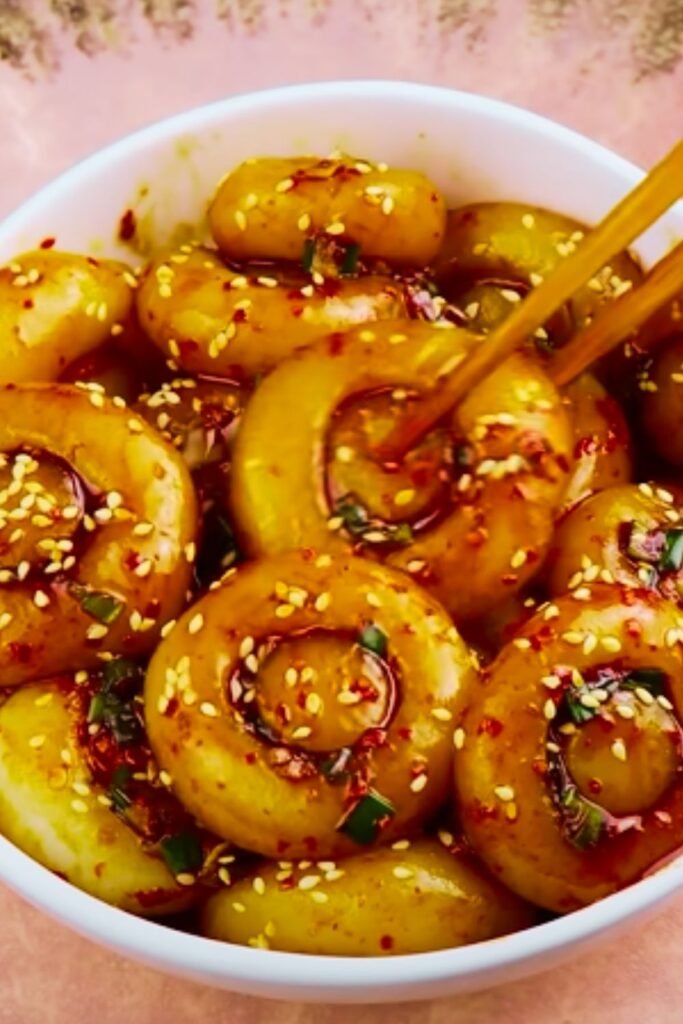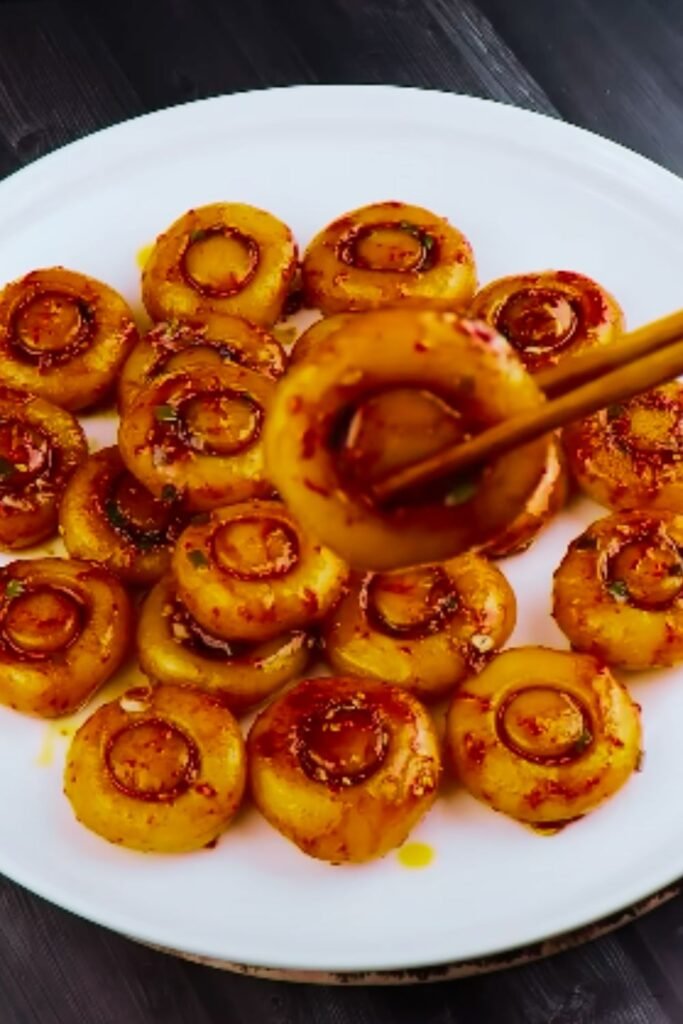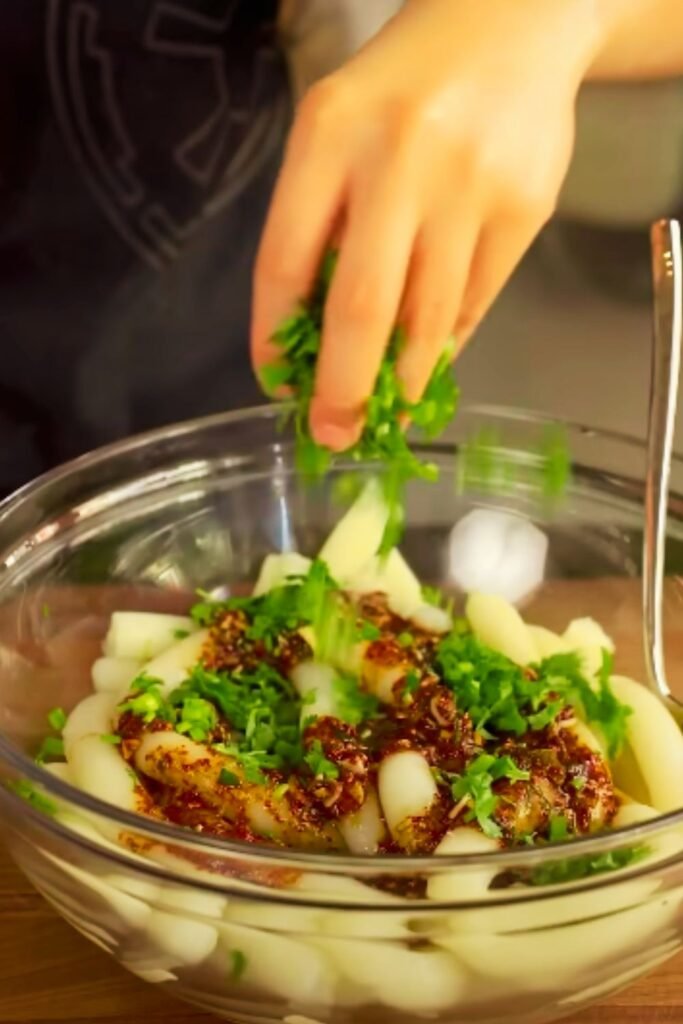Have you ever wondered what to do with those extra potatoes sitting in your pantry? Today, I’m excited to share one of my favorite recipes that transforms humble potatoes into delectable homemade noodles. These potato noodles, also known as potato pasta, are not only budget-friendly but also gluten-free and incredibly versatile.
Why You’ll Love This Recipe
As someone who’s been making potato noodles for years, I can tell you that they’re a game-changer in the kitchen. The texture is uniquely silky, with a slight bite that makes them perfect for both Western and Asian-inspired dishes. What I particularly love about these noodles is their ability to absorb sauces while maintaining their structure – something that took me countless attempts to perfect.
Essential Ingredients
| Ingredient | Quantity | Notes |
|---|---|---|
| Russet Potatoes | 4 large (about 2 lbs) | High starch content ideal for noodles |
| Potato Starch | 1 cup | Helps achieve the right texture |
| Salt | 1 teaspoon | Enhances flavor and texture |
| Egg | 1 large | Acts as a binder |
| Water | 2-3 tablespoons | Add as needed |
| Rice Flour | For dusting | Prevents sticking |

Kitchen Equipment Needed
| Equipment | Purpose |
|---|---|
| Potato Ricer or Food Mill | Creates smooth potato base |
| Large Mixing Bowl | For combining ingredients |
| Rolling Pin | For flattening dough |
| Sharp Knife or Pasta Cutter | For cutting noodles |
| Clean Kitchen Towels | For covering dough while resting |
| Large Pot | For cooking noodles |
| Colander | For draining |
Step-by-Step Instructions
1. Preparing the Potatoes
- Wash and peel the potatoes
- Cut into uniform 2-inch chunks
- Place in cold water
- Bring to a boil and cook until tender (about 15-20 minutes)
- Drain thoroughly
- Pass through potato ricer while still hot
Pro Tip: Never use a food processor for mashing – it makes the potatoes gummy.
2. Making the Dough
- Spread riced potatoes on a clean surface to cool slightly
- Create a well in the center
- Add beaten egg and salt
- Gradually incorporate potato starch
- Knead gently until smooth (about 5 minutes)
- Let rest for 30 minutes, covered

3. Forming the Noodles
- Divide dough into 4 portions
- Roll each portion to 1/8 inch thickness
- Dust with rice flour
- Cut into desired width (I prefer 1/4 inch for versatility)
- Hang or lay flat on floured surface
4. Cooking Instructions
| Cooking Method | Time | Tips |
|---|---|---|
| Fresh Noodles | 3-4 minutes | In boiling salted water |
| Stored Noodles | 4-5 minutes | From refrigerator |
| Frozen Noodles | 5-6 minutes | Do not thaw first |

Storage and Make-Ahead Tips
| Storage Method | Duration | Instructions |
|---|---|---|
| Refrigerator | Up to 2 days | Dust with starch, store in airtight container |
| Freezer | Up to 3 months | Flash freeze on tray, then transfer to freezer bag |
| Room Temperature | Use immediately | Best when fresh |
Serving Suggestions
These versatile noodles work beautifully in many dishes:
- Asian-Style Preparations:
- Stir-fried with vegetables and sesame oil
- In hot pot or soup
- With spicy Sichuan sauce
- Western Preparations:
- Tossed with brown butter and sage
- With mushroom cream sauce
- In chicken noodle soup
- Light Options:
- With fresh pesto and cherry tomatoes
- Tossed with olive oil and herbs
- In a light vegetable broth
Troubleshooting Common Issues
| Problem | Cause | Solution |
|---|---|---|
| Sticky Dough | Too much moisture | Add more potato starch gradually |
| Crumbly Dough | Too dry | Sprinkle water, one teaspoon at a time |
| Noodles Breaking | Incorrect thickness | Roll to uniform 1/8 inch thickness |
| Gummy Texture | Overcooked | Cook until just al dente |
Nutritional Information
(Per serving – approximately 1 cup cooked noodles)
| Nutrient | Amount |
|---|---|
| Calories | 220 |
| Protein | 4g |
| Carbohydrates | 48g |
| Fiber | 3g |
| Fat | 1g |
| Sodium | 245mg |
Questions and Answers
Q: Can I make these noodles without eggs?
Yes! Replace the egg with 3 tablespoons of aquafaba (chickpea liquid) or commercial egg replacer. The texture will be slightly different but still delicious.
Q: Why are my noodles falling apart in the water?
This usually happens when there’s not enough starch binding the dough. Make sure to use the full amount of potato starch and let the dough rest properly before rolling.
Q: Can I use sweet potatoes instead?
While possible, sweet potatoes have different starch content. You’ll need to adjust the potato starch ratio – start with 25% less and adjust as needed.
Q: How do I prevent the noodles from sticking together?
Dust generously with rice flour between layers when storing, and never overcrowd the pot when cooking. Stir gently right after adding to boiling water.
Q: Can I dry these noodles like regular pasta?
I don’t recommend it. These noodles are best used fresh or frozen. The unique potato structure makes them prone to breaking when dried completely.
Tips for Success
- Temperature Matters
- Use potatoes while they’re still hot
- Keep water boiling vigorously when cooking
- Serve immediately for best texture
- Texture Indicators
- Dough should be pliable but not sticky
- Surface should be smooth, not cracked
- Cooked noodles should be tender but firm
- Working Ahead
- Prepare dough up to 24 hours in advance
- Store covered in refrigerator
- Bring to room temperature before rolling
- Scaling the Recipe
- Double ingredients for larger batches
- Work in portions for easier handling
- Freeze excess in meal-sized portions
Remember, making potato noodles is both an art and a science. Don’t be discouraged if your first batch isn’t perfect – with practice, you’ll develop a feel for the right texture and consistency. I’ve made these countless times, and each batch teaches me something new about this wonderful, versatile dish.
Whether you’re looking for a gluten-free pasta alternative or simply want to try something new, these potato noodles are sure to become a staple in your kitchen. They’re economical, satisfying, and infinitely customizable. Give them a try, and let the creative cooking begin!


